30+ Acrostic Poem Examples to Download
Creativity is a very important concept that allows us to create unique things, objects, and concepts. One of the most creative types of poems is the acrostic poem.
What is an Acrostic Poem?
An acrostic poem is a type of poetry where the first letter, syllable, or word of each line spells out a word, message, or the alphabet. This word or message runs vertically down the side of the poem, serving as a spine or framework for the poem itself. Acrostic poems are a creative way to convey themes and messages, intertwining the literal content of the poem with the word or phrase spelled out by its lines.

Acrostic Poem Format
Acrostic Poem Template: “POEM”
P [Your line here]
O [Your line here]
E [Your line here]
M [Your line here]Instructions:
- Choose a Word or Name: For this template, we’ve chosen “POEM.” You can select any word, name, or phrase that inspires you.
- Write Your Lines:
- For P: Think of a word, phrase, or sentence that starts with “P” and relates to your theme or subject.
- For O: Do the same for “O,” considering how it can connect to or build upon the first line.
- For E: Find a word, phrase, or sentence starting with “E” that adds further depth or insight.
- For M: Conclude with a line that starts with “M,” wrapping up your poem or adding a final thought.
- Be Creative: Your lines can be as literal or as abstract as you like. They can tell a story, describe an emotion, or paint a picture that relates to your central word or theme.
- Adjust and Refine: Feel free to revise your lines to improve flow, add depth, or enhance clarity. The beauty of an acrostic poem is in how the vertical element ties into the rest of your text.
Example Using “POEM”:
Paints a picture with words, silently,
Offering a glimpse into the soul’s depths,
Emotions and thoughts, woven intricately,
Memories etched in lines that time respects.
Acrostic Poem Features
- ertical Word or Phrase: The first letters of each line, when read vertically, spell out a word, message, or alphabet sequence.
- Thematic Consistency: The content of the poem usually relates to or expands upon the theme suggested by the vertical word or phrase.
- Flexibility in Length: There is no fixed length; acrostic poems can be short or long, depending on the word or phrase used.
- Varied Line Structure: While the acrostic element typically involves the first letter of each line, it can also use syllables, words, or parts of words.
- Creative Freedom: Beyond the acrostic constraint, poets have creative freedom with the use of rhyme, meter, and poetic devices.
- Engages Readers: The acrostic element often engages readers, inviting them to look deeper into the poem for hidden messages or meanings.
- Accessible to All Ages: Acrostic poems are popular in educational settings, as they are accessible for writers of all ages and skill levels.
- Can Be Used for Various Purposes: Acrostics can serve different purposes, from simple exercises in creativity to complex expressions of personal feelings or political statements.
- Historical Use: Acrostic poems have a long history, used in ancient times through to modern poetry, showing the form’s enduring appeal.
- Versatility: They can be written on any subject, making them versatile tools for expressing a wide range of themes and ideas
How to Write an Acrostic Poem?
Writing an acrostic poem is a fun and creative process. Here are the steps to guide you in crafting your own acrostic poem:
1. Choose Your Word or Phrase
- Begin by selecting a word or phrase that will serve as the backbone of your poem. This could be a name, a concept, a feeling, or any subject you feel inspired to write about.
2. Write Down Your Word Vertically
- Write your chosen word or phrase vertically down the page. Each letter will be the first letter of each line of your poem.
3. Decide on a Theme or Message
- Think about what you want to convey through your poem. The theme or message should be related to or inspired by your chosen word or phrase.
4. Brainstorm Words or Phrases for Each Letter
- For each letter in your vertical word or phrase, brainstorm words, phrases, or sentences that start with that letter and relate to your theme.
5. Craft Your Lines
- Begin crafting each line of your poem. Each line should start with the corresponding letter and fit with the overall theme or message of your poem. Remember, there’s no need to rhyme unless you want to!
6. Adjust for Flow and Coherence
- Read your poem aloud to check for flow and coherence. Adjust the lines as necessary to ensure that they make sense both individually and as part of the whole poem.
7. Refine and Edit
- Refine your poem by making any necessary edits. Look for opportunities to enhance imagery, emotion, and impact.
8. Share Your Poem
- Once you’re satisfied with your acrostic poem, share it with others. Acrostic poems can make thoughtful gifts or personal messages, and they are also great for sharing in educational settings or among fellow poetry enthusiasts.
Famous Acrostic Poems
One famous example of an acrostic poem is “A Boat Beneath a Sunny Sky” by Lewis Carroll, which is the final poem in his novel “Through the Looking-Glass.”
“A Boat Beneath a Sunny Sky” (Excerpt)
A Boat beneath a sunny sky,
Lingering onward dreamily
In an evening of July —
Children three that nestle near,
Eager eye and willing ear,
Pleased a simple tale to hear —
Long has paled that sunny sky:
Echoes fade and memories die:
Autumn frosts have slain July.
Still she haunts me, phantomwise,
Alice moving under skies
Never seen by waking eyes.
Children yet, the tale to hear,
Eager eye and willing ear,
Lovingly shall nestle near.
Life, what is it but a dream?
Acrostic Poems Using the First Letter
acrostic poems using the first letter of each line is a popular and accessible form of this poetic technique. Here’s an example using the word LIGHT:
Luminous beams quietly dispel the night,
Illuminating darkness with gentle might.
Guiding travelers on their weary way,
Heralding the dawn of a brand new day.
Tales of hope whispered with each ray.
Acrostic Poem Examples Using Different Positions
Acrostic poems can creatively use different positions within the lines to spell out words or messages, not just the first letter of each line. Here are examples showcasing various approaches:
1. Middle Acrostic
- Word: DREAM
- Example:
- Sunshine fills the Day,
- Rivers flow, Ever on their way,
- Across the mountains, Across the plains,
- Moonlight in the night Maintains.
2. End Acrostic
- Word: NIGHT
- Example:
- Stars shininN,
- Whispering trees, midnighI,
- Gentle breezes, soft sigG,
- Hooting owl, silent fligH,
- Twilight fades, day is ouT.
3. Diagonal Acrostic
- Word: PATH
- Example: (Here, the word starts from the top left and moves diagonally down to the right)
- Peaceful mornings,
- sAnds beneath my feet,
- tHrough the woods so deep,
- loTs of memories to keep.
4. Telestich (End Letter) Acrostic
- Word: PEACE
- Example:
- Horizon line blends sea and skY,
- Evening whispers soft goodbyE,
- All worries under the night caP,
- Calming the world in a nighttimE embrace,
- Every star a wish at peacE.
5. Double Acrostic (First and Last Letter)
- Word: STAR
- Example:
- Silence covers all, So profound,
- Twilight’s last gleam fades, Twilight bound,
- Above, the cosmos whispers, A cosmic sound,
- Revealing beauty all around, Reverently found.
6. Mesostich (Middle Letter) Acrostic
- Word: TIME
- Example:
- MoTher Nature’s endless flow,
- In Intervals, the seasons go,
- MiDnight moon and sun’s high beam,
- EvEry moment, a dream.
Acrostic Poems That Spell Names
acrostic poems that spell out names is a personalized and thoughtful way to convey admiration, affection, or simply to celebrate someone. Here are examples for two common names, “Emma” and “John”:
For “Emma”:
Every morning brings your smile to mind,
Memories of laughter, sweet and kind.
Moments with you, precious and few,
Always cherished, forever true.
For “John”:
Journeys embarked upon with zest,
Overcoming every test.
Heart of gold, strong and true,
Never faltering, through and through.
Acrostic Poem Examples from Literature
Acrostic poems have been utilized in literature for centuries, offering hidden messages or simply showcasing the poet’s wit and creativity. Here are two notable examples from literature:
1. “Elizabeth” by Edgar Allan Poe
This poem is a touching tribute to Elizabeth Rebecca Herring, Poe’s cousin. Each line starts with a letter from her name:
Elizabeth it is in vain you say
Love not — thou sayest it in so sweet a way:
In vain those words from thee or L.E.L.
Zantippe’s talents had enforced so well:
Ah! if that language from thy heart arise,
Breath it less gently forth — and veil thine eyes.
Endymion, recollect, when Luna tried
To cure his love — was cured of all beside —
His folly — pride — and passion — for he died.
2. An Acrostic by Lewis Carroll
Lewis Carroll’s “A Boat Beneath a Sunny Sky” is an acrostic that spells out the name of Alice Pleasance Liddell, the real-life inspiration for his “Alice” in Wonderland stories:
A boat beneath a sunny sky,
Lingering onward dreamily
In an evening of July —
Children three that nestle near,
Eager eye and willing ear,
And continues with each line starting with the subsequent letters of her full name.
Acrostic Poem Template
How to teach Acrostic Poems to children
1. Acrostic Poems Template
2. Acrostic Poem Adjective Word List
3. Acrostic Poem Shape Pattern
4. Going Vertical Acrostic Poem
5. Acrostic Poem Generation
6. Garden Acrostic Poem
7. Social Justice Acrostic Poem
8. Introduction Assignment Acrostic Poem
9. Acrostic Poem Quest
10. Spring Acrostic Poem
11. Amazing Acrostic Poems
12. Friendship Acrostic Poem
13. Acrostic Poem Rubric
14. Advanced Acrostic Poem
15. Brussels Sprouts Acrostic Poem Lesson Plan
16. Acrostic Poem Activity Sheet
17. Entry Activity Sheet Acrostic Poem
18. Acrostic Poem Notes
19. Acrostic Poem Example
FAQs
Are Acrostic Poems for Kids?
Acrostic poems are excellent for kids as they combine creativity with structure, making it easier for children to engage with poetry. They also serve as a fun way to teach vocabulary and express themselves.
What is Acrostic Format?
The acrostic format involves writing a word or phrase vertically down the page and using each letter as the starting point for each line of the poem. The content of the poem typically relates to or expands upon the theme suggested by the vertical word or phrase.
What is an Acrostic Poem Called?
An acrostic poem is simply called an “acrostic.” This term refers to a type of poem where the first letter of each line spells out a word or message when read vertically.
What is the Main Acrostic Poem?
There isn’t a single “main” acrostic poem; rather, this term refers to any poem that uses the acrostic technique to spell out words or messages with the first letter of each line. Acrostics can vary widely in theme and style.
What are the types of acrostics?
In the most common kind of acrostic poetry, each line’s initial letter becomes a word. This particular type is referred known as “acrostic.” There are special names for other acrostic types, though, that use more precise placements of the letters to spell out the word or phrase. The acrostic of the telestich spells out a word or message using the final letters of each line. A mesostich is a word or message created by the middle of each word or line in an acrostic. Another sort of acrostic is a double acrostic, which uses the first and last letters of each line to spell words, allowing readers to read one word vertically down.
How would you identify acrostics?
When read vertically, an acrostic poem is one in which certain letters from each line come together to spell out a word, name, or phrase. The initial letter of each line most frequently forms the word, but they can be positioned wherever on the line.
Who invented acrostics?
The first letters of each line of a short poem written in the acrostic style form words when placed together. The expression was first used in the Erythraean Sibyl’s prophecies, which she wrote on leaves and arranged such that the first letters of each leaf always made a word. The Greek playwrights of the Alexandrine era as well as the Latin writers Ennuis and Plautus both regularly utilized acronyms; the word is derived from the Greek phrases akros, “at the end,” and stichos, “line.” Medieval poets and monks helped spread this kind of poetry during the Middle High German and Italian Renaissance eras.
An acrostic poem is a type of structured poetry that hinges on the utilization of letters in specific locations to create a creative poem. A lot of well-made acrostics can easily and creatively showcase the poet’s creativity while being readable at the same time.
30+ Acrostic Poem Examples to Download
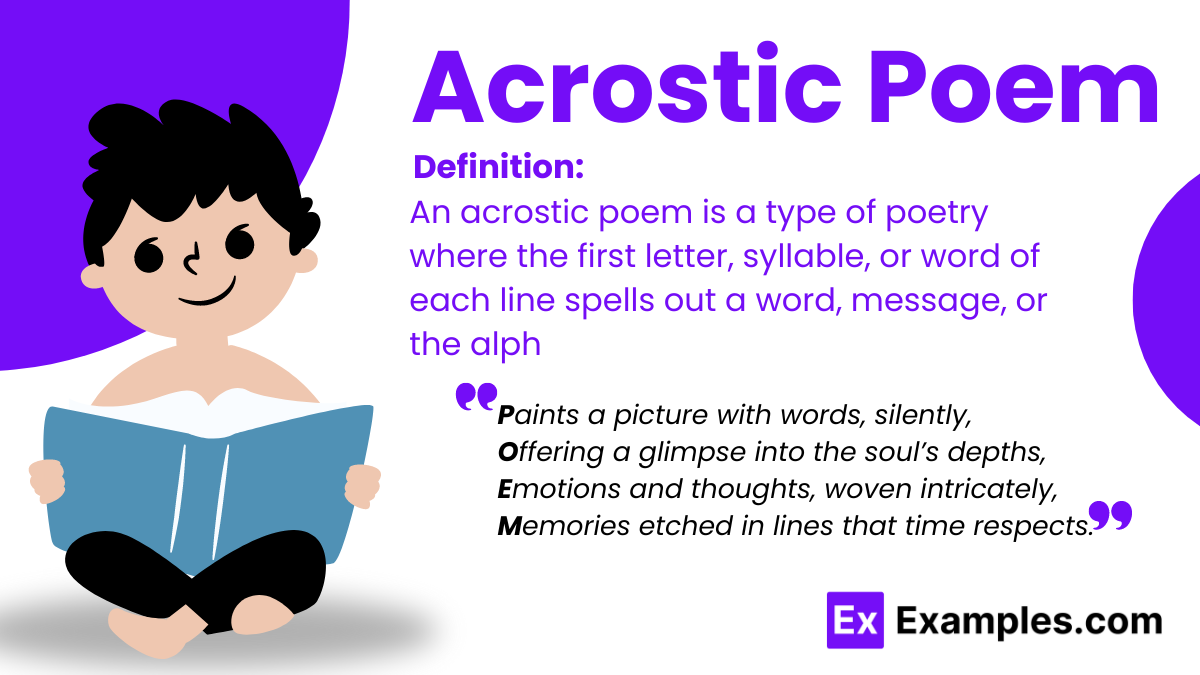
Creativity is a very important concept that allows us to create unique things, objects, and concepts. One of the most creative types of poems is the acrostic poem.
What is an Acrostic Poem?
An acrostic poem is a type of poetry where the first letter, syllable, or word of each line spells out a word, message, or the alphabet. This word or message runs vertically down the side of the poem, serving as a spine or framework for the poem itself. Acrostic poems are a creative way to convey themes and messages, intertwining the literal content of the poem with the word or phrase spelled out by its lines.

Acrostic Poem Format
Acrostic Poem Template: “POEM”
P [Your line here]
O [Your line here]
E [Your line here]
M [Your line here]Instructions:
Choose a Word or Name: For this template, we’ve chosen “POEM.” You can select any word, name, or phrase that inspires you.
Write Your Lines:
For P: Think of a word, phrase, or sentence that starts with “P” and relates to your theme or subject.
For O: Do the same for “O,” considering how it can connect to or build upon the first line.
For E: Find a word, phrase, or sentence starting with “E” that adds further depth or insight.
For M: Conclude with a line that starts with “M,” wrapping up your poem or adding a final thought.
Be Creative: Your lines can be as literal or as abstract as you like. They can tell a story, describe an emotion, or paint a picture that relates to your central word or theme.
Adjust and Refine: Feel free to revise your lines to improve flow, add depth, or enhance clarity. The beauty of an acrostic poem is in how the vertical element ties into the rest of your text.
Example Using “POEM”:
Paints a picture with words, silently,
Offering a glimpse into the soul’s depths,
Emotions and thoughts, woven intricately,
Memories etched in lines that time respects.
Acrostic Poem Features
ertical Word or Phrase: The first letters of each line, when read vertically, spell out a word, message, or alphabet sequence.
Thematic Consistency: The content of the poem usually relates to or expands upon the theme suggested by the vertical word or phrase.
Flexibility in Length: There is no fixed length; acrostic poems can be short or long, depending on the word or phrase used.
Varied Line Structure: While the acrostic element typically involves the first letter of each line, it can also use syllables, words, or parts of words.
Creative Freedom: Beyond the acrostic constraint, poets have creative freedom with the use of rhyme, meter, and poetic devices.
Engages Readers: The acrostic element often engages readers, inviting them to look deeper into the poem for hidden messages or meanings.
Accessible to All Ages: Acrostic poems are popular in educational settings, as they are accessible for writers of all ages and skill levels.
Can Be Used for Various Purposes: Acrostics can serve different purposes, from simple exercises in creativity to complex expressions of personal feelings or political statements.
Historical Use: Acrostic poems have a long history, used in ancient times through to modern poetry, showing the form’s enduring appeal.
Versatility: They can be written on any subject, making them versatile tools for expressing a wide range of themes and ideas
How to Write an Acrostic Poem?
Writing an acrostic poem is a fun and creative process. Here are the steps to guide you in crafting your own acrostic poem:
1. Choose Your Word or Phrase
Begin by selecting a word or phrase that will serve as the backbone of your poem. This could be a name, a concept, a feeling, or any subject you feel inspired to write about.
2. Write Down Your Word Vertically
Write your chosen word or phrase vertically down the page. Each letter will be the first letter of each line of your poem.
3. Decide on a Theme or Message
Think about what you want to convey through your poem. The theme or message should be related to or inspired by your chosen word or phrase.
4. Brainstorm Words or Phrases for Each Letter
For each letter in your vertical word or phrase, brainstorm words, phrases, or sentences that start with that letter and relate to your theme.
5. Craft Your Lines
Begin crafting each line of your poem. Each line should start with the corresponding letter and fit with the overall theme or message of your poem. Remember, there’s no need to rhyme unless you want to!
6. Adjust for Flow and Coherence
Read your poem aloud to check for flow and coherence. Adjust the lines as necessary to ensure that they make sense both individually and as part of the whole poem.
7. Refine and Edit
Refine your poem by making any necessary edits. Look for opportunities to enhance imagery, emotion, and impact.
8. Share Your Poem
Once you’re satisfied with your acrostic poem, share it with others. Acrostic poems can make thoughtful gifts or personal messages, and they are also great for sharing in educational settings or among fellow poetry enthusiasts.
Famous Acrostic Poems
One famous example of an acrostic poem is “A Boat Beneath a Sunny Sky” by Lewis Carroll, which is the final poem in his novel “Through the Looking-Glass.”
“A Boat Beneath a Sunny Sky” (Excerpt)
A Boat beneath a sunny sky,
Lingering onward dreamily
In an evening of July —
Children three that nestle near,
Eager eye and willing ear,
Pleased a simple tale to hear —
Long has paled that sunny sky:
Echoes fade and memories die:
Autumn frosts have slain July.
Still she haunts me, phantomwise,
Alice moving under skies
Never seen by waking eyes.
Children yet, the tale to hear,
Eager eye and willing ear,
Lovingly shall nestle near.
Life, what is it but a dream?
Acrostic Poems Using the First Letter
acrostic poems using the first letter of each line is a popular and accessible form of this poetic technique. Here’s an example using the word LIGHT:
Luminous beams quietly dispel the night,
Illuminating darkness with gentle might.
Guiding travelers on their weary way,
Heralding the dawn of a brand new day.
Tales of hope whispered with each ray.
Acrostic Poem Examples Using Different Positions
Acrostic poems can creatively use different positions within the lines to spell out words or messages, not just the first letter of each line. Here are examples showcasing various approaches:
1. Middle Acrostic
Word: DREAM
Example:
Sunshine fills the Day,
Rivers flow, Ever on their way,
Across the mountains, Across the plains,
Moonlight in the night Maintains.
2. End Acrostic
Word: NIGHT
Example:
Stars shininN,
Whispering trees, midnighI,
Gentle breezes, soft sigG,
Hooting owl, silent fligH,
Twilight fades, day is ouT.
3. Diagonal Acrostic
Word: PATH
Example: (Here, the word starts from the top left and moves diagonally down to the right)
Peaceful mornings,
sAnds beneath my feet,
tHrough the woods so deep,
loTs of memories to keep.
4. Telestich (End Letter) Acrostic
Word: PEACE
Example:
Horizon line blends sea and skY,
Evening whispers soft goodbyE,
All worries under the night caP,
Calming the world in a nighttimE embrace,
Every star a wish at peacE.
5. Double Acrostic (First and Last Letter)
Word: STAR
Example:
Silence covers all, So profound,
Twilight’s last gleam fades, Twilight bound,
Above, the cosmos whispers, A cosmic sound,
Revealing beauty all around, Reverently found.
6. Mesostich (Middle Letter) Acrostic
Word: TIME
Example:
MoTher Nature’s endless flow,
In Intervals, the seasons go,
MiDnight moon and sun’s high beam,
EvEry moment, a dream.
Acrostic Poems That Spell Names
acrostic poems that spell out names is a personalized and thoughtful way to convey admiration, affection, or simply to celebrate someone. Here are examples for two common names, “Emma” and “John”:
For “Emma”:
Every morning brings your smile to mind,
Memories of laughter, sweet and kind.
Moments with you, precious and few,
Always cherished, forever true.
For “John”:
Journeys embarked upon with zest,
Overcoming every test.
Heart of gold, strong and true,
Never faltering, through and through.
Acrostic Poem Examples from Literature
Acrostic poems have been utilized in literature for centuries, offering hidden messages or simply showcasing the poet’s wit and creativity. Here are two notable examples from literature:
1. “Elizabeth” by Edgar Allan Poe
This poem is a touching tribute to Elizabeth Rebecca Herring, Poe’s cousin. Each line starts with a letter from her name:
Elizabeth it is in vain you say
Love not — thou sayest it in so sweet a way:
In vain those words from thee or L.E.L.
Zantippe’s talents had enforced so well:
Ah! if that language from thy heart arise,
Breath it less gently forth — and veil thine eyes.
Endymion, recollect, when Luna tried
To cure his love — was cured of all beside —
His folly — pride — and passion — for he died.
2. An Acrostic by Lewis Carroll
Lewis Carroll’s “A Boat Beneath a Sunny Sky” is an acrostic that spells out the name of Alice Pleasance Liddell, the real-life inspiration for his “Alice” in Wonderland stories:
A boat beneath a sunny sky,
Lingering onward dreamily
In an evening of July —
Children three that nestle near,
Eager eye and willing ear,
And continues with each line starting with the subsequent letters of her full name.
Acrostic Poem Template
How to teach Acrostic Poems to children
1. Acrostic Poems Template

learnenglishkids.britishcouncil.org
2. Acrostic Poem Adjective Word List
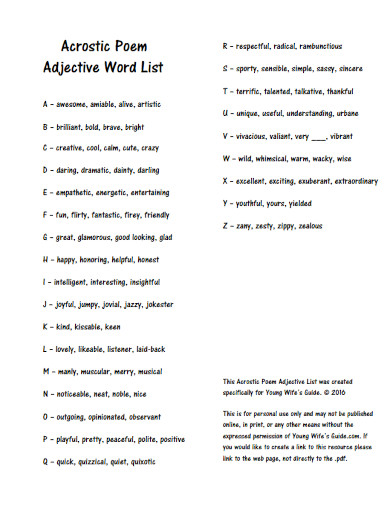
findingjoyinyourhome.com
3. Acrostic Poem Shape Pattern
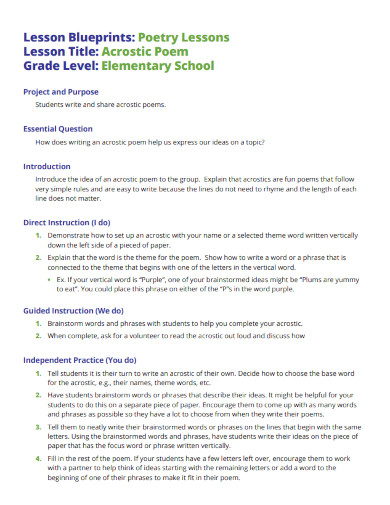
s3.amazonaws.com
4. Going Vertical Acrostic Poem
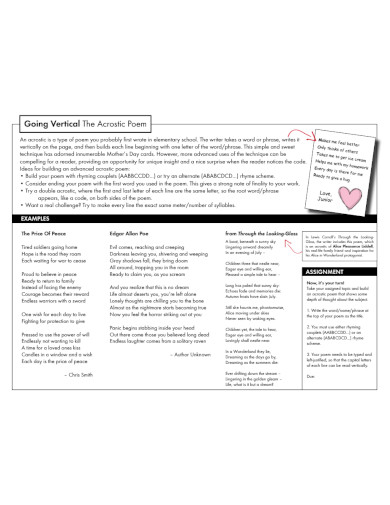
frontiercsd.org
5. Acrostic Poem Generation
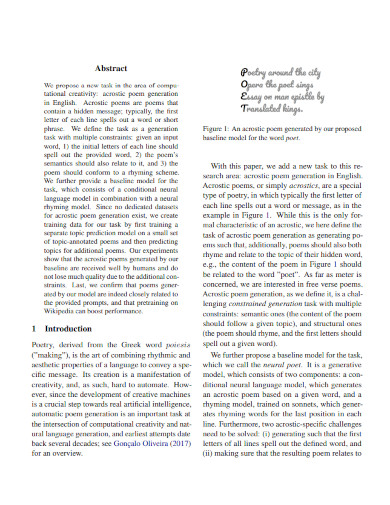
aclanthology.org
6. Garden Acrostic Poem
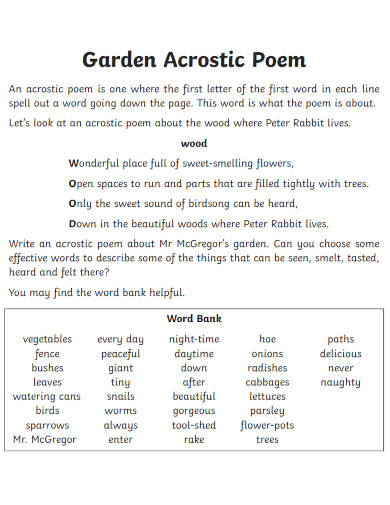
rocklands.norfolk.sch.uk
7. Social Justice Acrostic Poem

assets2.hrc.org
8. Introduction Assignment Acrostic Poem
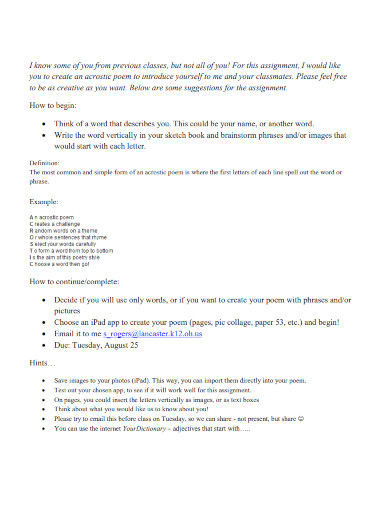
lancaster.k12.oh.us
9. Acrostic Poem Quest

assets.speakcdn.com
10. Spring Acrostic Poem

nj.gov
11. Amazing Acrostic Poems

bath-preservation-trust.org.uk
12. Friendship Acrostic Poem
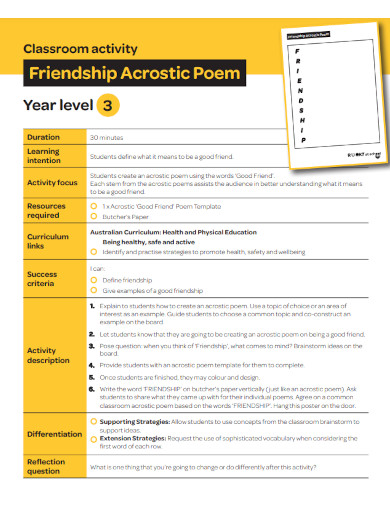
irp.cdn-website.com
13. Acrostic Poem Rubric
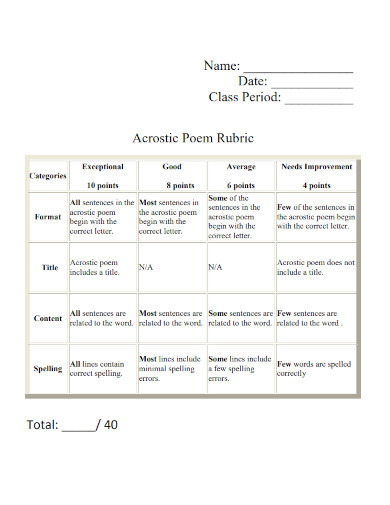
enetlearning.org
14. Advanced Acrostic Poem
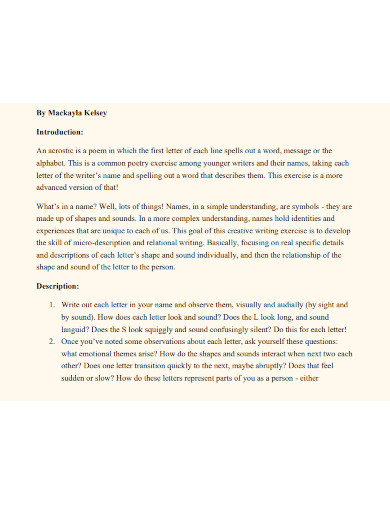
civicnebraska.org
15. Brussels Sprouts Acrostic Poem Lesson Plan
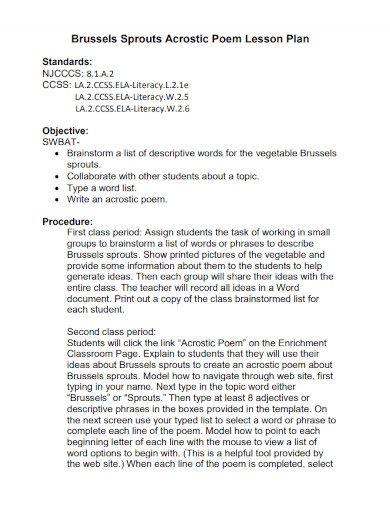
img1.wsimg.com
16. Acrostic Poem Activity Sheet
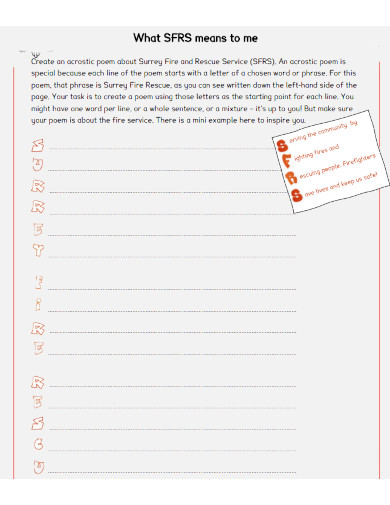
surreycc.gov.uk
17. Entry Activity Sheet Acrostic Poem
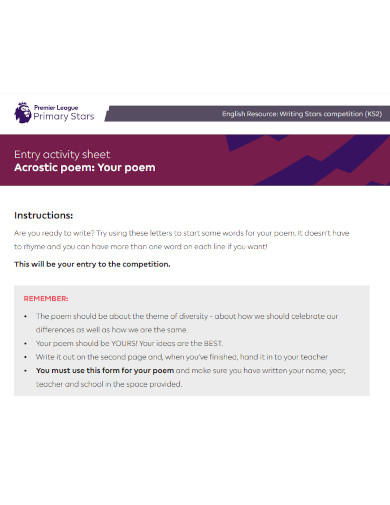
cuctrust.co.uk
18. Acrostic Poem Notes
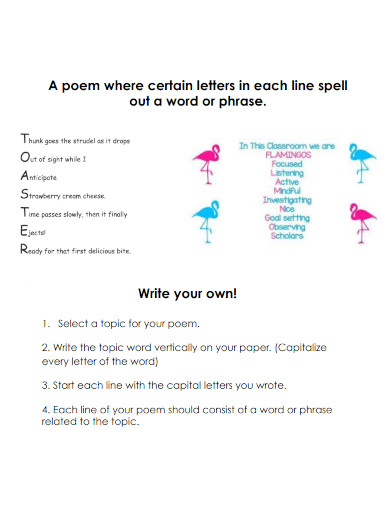
clark-shawnee.k12.oh.us
19. Acrostic Poem Example
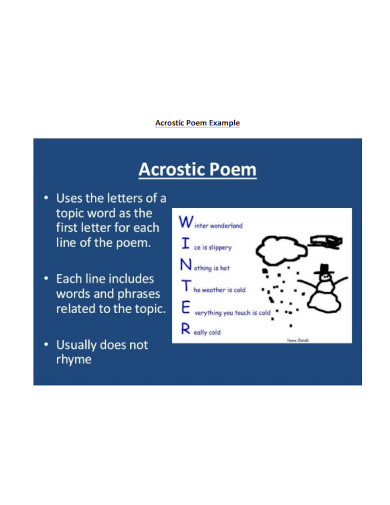
naascns.ie
FAQs
Are Acrostic Poems for Kids?
Acrostic poems are excellent for kids as they combine creativity with structure, making it easier for children to engage with poetry. They also serve as a fun way to teach vocabulary and express themselves.
What is Acrostic Format?
The acrostic format involves writing a word or phrase vertically down the page and using each letter as the starting point for each line of the poem. The content of the poem typically relates to or expands upon the theme suggested by the vertical word or phrase.
What is an Acrostic Poem Called?
An acrostic poem is simply called an “acrostic.” This term refers to a type of poem where the first letter of each line spells out a word or message when read vertically.
What is the Main Acrostic Poem?
There isn’t a single “main” acrostic poem; rather, this term refers to any poem that uses the acrostic technique to spell out words or messages with the first letter of each line. Acrostics can vary widely in theme and style.
What are the types of acrostics?
In the most common kind of acrostic poetry, each line’s initial letter becomes a word. This particular type is referred known as “acrostic.” There are special names for other acrostic types, though, that use more precise placements of the letters to spell out the word or phrase. The acrostic of the telestich spells out a word or message using the final letters of each line. A mesostich is a word or message created by the middle of each word or line in an acrostic. Another sort of acrostic is a double acrostic, which uses the first and last letters of each line to spell words, allowing readers to read one word vertically down.
How would you identify acrostics?
When read vertically, an acrostic poem is one in which certain letters from each line come together to spell out a word, name, or phrase. The initial letter of each line most frequently forms the word, but they can be positioned wherever on the line.
Who invented acrostics?
The first letters of each line of a short poem written in the acrostic style form words when placed together. The expression was first used in the Erythraean Sibyl’s prophecies, which she wrote on leaves and arranged such that the first letters of each leaf always made a word. The Greek playwrights of the Alexandrine era as well as the Latin writers Ennuis and Plautus both regularly utilized acronyms; the word is derived from the Greek phrases akros, “at the end,” and stichos, “line.” Medieval poets and monks helped spread this kind of poetry during the Middle High German and Italian Renaissance eras.
An acrostic poem is a type of structured poetry that hinges on the utilization of letters in specific locations to create a creative poem. A lot of well-made acrostics can easily and creatively showcase the poet’s creativity while being readable at the same time.

